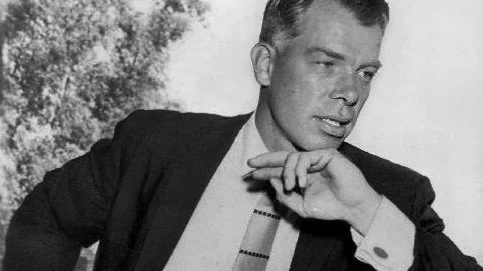Celebrating a century of Lee Marvin, the proud Marine who became, and still is, the ultimate movie tough guy
Lee Marvin would have turned 100 a few days ago.
Which was never going to happen. Not Lee Marvin. Not the way he lived and died.
Marvin, the ice-cold movie tough guy, with a head of white hair and a soul filled with quiet venom, died on Aug. 29, 1987. He was just 63, but in Lee Marvin years, that was, what, 427?
Despite his well-earned image as a dangerous man on or off-screen, Marvin (seen above in a public domain image posted on wikimedia commons) was born into comfort in New York City on Feb. 19, 2024. His father Lamont Waltman Marvin — called “The Chief” by his son — was an advertising executive. His mother, Courtenay “Court” Washington Davidge Marvin, wrote for fashion magazines.
Lamont Waltman Marvin Jr., aka Lee, was enrolled and kicked out of several of the best prep schools. Although studied the violin, he preferred hunting, smoking and getting into fights.
He followed in his father’s footsteps by becoming a Marine and serving in combat in Asia during World War II as a scout sniper in the 24th Regiment of the 4th Marine Division. He took part in multiple amphibious assaults on islands the Japanese intended to hold at any cost.
During the Battle of Saipan, Marvin was wounded — “shot in the ass,” he liked to tell reporters and talk show hosts — on June 18, 1944, while the Marines took Mount Tapochau. He was also wounded in the foot, but the bullet in the rear severed his sciatic nerve and landed him in naval hospitals for more than a year.
In a 1981 interview with Robert Ward for Rolling Stone, Marvin said that prepared him for his next career.
“I’ll tell you how. It was the Marines who taught me how to act,” he said over a drink or 50. “After that, pretending to be rough wasn’t so hard.”
Marvin started out in Hollywood as a bit player, and his military experience helped him land roles, since he could also serve as a technical adviser. He moved onto bigger parts, usually as a snarling bad guy.
Marvin made a name for himself as a vicious killer who abused women for fun in the 1953 film noir classic, “The Big Heat.” While he tangled with star Glenn Ford, the scene where he threw a pot of scalding-hot coffee into the face of blond mob moll Gloria Grahame shocked audiences — and it still does.
He also stood out as one of the bikers known as The Beetles — some young rockers in Liverpool might have noticed it — in the movie “The Wild One” starring Marlon Brando.
Now a name, he moved into bigger roles in films while also making some TV appearances. Marvin’s lean physique and cynical stare often intimidated his fellow performers, who admitted they weren’t sure how much was acting and how much was him expressing an inner turmoil.
In the 1961 nostalgic Western “The Man Who Shot Liberty Valance,” Marvin stood out as the, what else, psychotic killer Liberty Valance. John Wayne and James Stewart were the headline stars, but Marvin’s performance dominated the movie.
Marvin drank hard in those years, and it aged him like whiskey in an oaken cask. His face developed deep lines and his hair turned stone white in his 40s as he became a major star. Still, women found him very attractive on and off-screen, as his rumbling voice and heavily hooded eyes created a dangerous air of sensuality.
Surprisingly, when he won an Oscar as best actor in 1966, it was for the comedic dual roles of the drunken Kid Shelleen and the tin-nosed assassin Tim Strawn in “Cat Ballou,” a musical comedy that also starred Jane Fonda.
Marvin was typically wry in his acceptance speech, referring to a memorable scene with a talented stunt animal.
“I think, though, half of this belongs to a horse someplace out in the valley,” he said, drawing gales of laughter.
There he was, a successful son, a dedicated Marine, a real-life tough guy who was the world’s favorite movie brawler, at the top of his profession. Marvin made several other excellent films — “Point Blank,” “The Professionals,” “The Dirty Dozen,” “Emperor of the North” and more.
He also cashed in by appearing in some flicks that required him to fire guns and cutting quips for a few weeks for a cool $1 million.
Marvin was enmeshed in a “palimony” lawsuit filed by a former lover, Michelle Triola, that drew a lot of attention but ended with him not having to surrender as much money as she demanded. He married for a second time, settled in Tucson and enjoyed time with family and a few close friends.
But the decades of hard living and hard drinking took a toll. He died of a heart attack at 63 in 1987 after intestinal issues sent him to a hospital. The New York Times headline was predictable: “Lee Marvin, Movie Tough Guy, Dies.”
Marvin was prouder of his service in the Marine Corps than his movie career. He was buried with full military honors in Arlington National Cemetery, with no mention of his acting success and worldwide fame.
Aside from the dates of his birth and death, his headstone just states: Lee Marvin. PFC. U.S. Marine Corps. World War II.
Tom Lawrence has written for several newspapers and websites in South Dakota and other states and contributed to The New York Times, NPR, The Telegraph, The Daily Beast and other media outlets. Reprint with permission.







